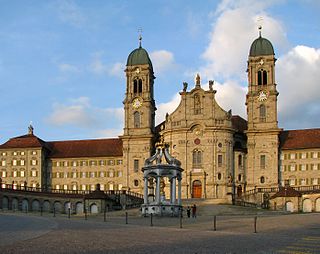
Leutfridus [1] was a French monk and saint of the eighth century.

Leutfridus [1] was a French monk and saint of the eighth century.
Leutfridus studied at Condat Abbey and at Chartres, and was for a time a teacher at Evreux. A Benedictine, he was also a spiritual student of Saint Sidonius of Saint-Saëns. He spent time as a hermit at Cailly and at Rouen. He founded the abbey of La Croix-Saint-Qu'en around 690, and served as its first abbot. [2] The abbey was later renamed Saint-Leufroy in his honor.
Leutfridus died in 738; [2] his feast day is June 21.
Leutfridus was the brother of Saint Agofredus.
The hagiographer Alban Butler wrote,
St. Leufredus, In French Leufroi, Abbot
HE was a native of the territory of Evreux, and performed his studies partly in the monastery of St. Taurinus at Evreux. Hearing the great sanctity of B. Sidonius, abbot near Rouen, much spoken of, he repaired to him, and received the monastic habit at his hands. By the advice of St. Anshert, archbishop of Rouen, he returned to his own country, and on a spot two leagues from Evreux, upon the Eure, where St. Owen had formerly erected a cross and a chapel, he built a monastery in honour of the cross, which he called the cross of St. Owen, but it is long since called the cross of St. Leufroi. Fasting, watching, and prayer were the constant exercises of his whole life, especially during forty years that he governed his monastery. [lower-alpha 1] He died happily after receiving the holy viaticum in 738, and was succeeded in the abbacy by his brother St. Agofroi. In the incursions of the Normans in the ninth century, the monks fled for refuge to the abbey of St. Germain-des-Prez at Paris, carrying with them the relics of St. Owen, St. Turiave, St. Leufroi and St. Agofroi. When they returned, they left in gratitude for their entertainment those of St. Leufroi and St. Turiave, which still remain in that great abbey. St. Leufroi is named in the Roman Martyrology on the 21st of June, and honoured with an office in the new Paris Breviary.
See his anonymous life written in the ninth age with the remarks of Mabillon, sæc. 3. Ben. part 1, p. 582; also Usuard, the life of St. Owen, &c. [3]

Saint Gall, or Gallus according to hagiographic tradition was a disciple and one of the traditional twelve companions of Saint Columbanus on his mission from Ireland to the continent. Saint Deicolus was the elder brother of Gall.

Einsiedeln Abbey is a Benedictine monastery in the village of Einsiedeln in the canton of Schwyz, Switzerland. The abbey is dedicated to Our Lady of the Hermits, the title being derived from the circumstances of its foundation, for the first inhabitant of the region was Saint Meinrad, a hermit. It is a territorial abbey and, therefore, not part of a diocese, subject to a bishop. It has been a major resting point on the Way of St. James for centuries.

June 20 - Eastern Orthodox Church calendar - June 22

Saint Maurus, O.S.B. was the first disciple of Saint Benedict of Nursia (512–584). He is mentioned in Saint Gregory the Great's biography of the latter as the first oblate, offered to the monastery by his noble Roman parents as a young boy to be brought up in the monastic life.

Ansbert, sometimes called Ansbert of Chaussy, was a Frankish monk, abbot and bishop of Rouen, today regarded as a saint in the Catholic Church.

Fleury Abbey (Floriacum) in Saint-Benoît-sur-Loire, Loiret, France, founded in about 640, is one of the most celebrated Benedictine monasteries of Western Europe, which possesses the relics of St. Benedict of Nursia. Its site on the banks of the Loire has always made it easily accessible from Orléans, a center of culture unbroken since Roman times. Today the abbey has over forty monks and is headed by the abbot Etienne Ricaud.
The Norman Guitmund, Bishop of Aversa, was a Benedictine monk who was an opponent of the teachings of Berengar of Tours.

Saint Winwaloe was the founder and first abbot of Landévennec Abbey, also known as the Monastery of Winwaloe. It was just south of Brest in Brittany, now part of France.

Saint-Saëns is a commune in the Seine-Maritime department in the Normandy region in northern France. A small town of farming and associated light industry situated by the banks of the river Varenne in the Pays de Bray, some 19 miles (31 km) southeast of Dieppe at the junction of the D929, D12, D99 and the D154 roads. Junction 11 of the A28 autoroute with the A29 autoroute is within the commune’s territory.
Sidonius was an Irish-born French monk and saint. He was the spiritual teacher of Leutfridus. He is venerated in the Roman Catholic Church and Eastern Orthodox Church.
Agofredus, also known as Aifroy, was a French monk and saint. His memorial is June 21.
Saint Taurinus of Évreux, also known as Saint Taurin, is venerated as a saint by the Catholic Church. His legend states that he was the first bishop of Évreux. He evangelized the region and died a martyr.

Condat Abbey was founded in the 420s in the valley of Bienne, in the Jura mountains, in modern-day France. Condat became the capital of Haut Jura. The founders were local monks, Romanus, who had been ordained by St. Hilary of Arles in 444, and his younger brother Lupicinus of Lyon (Lupicin); the easily defended isolated site they chose for the separate cells in which they and their followers would live in emulation of the Eastern manner of the Desert Fathers was on a stony headland at the confluence of the rivers Bienne and Tacon. Though the site still contained Roman ruins, it was accounted a 'desert' in the Life of the Fathers of the Jura, which contains the early saint's lives. Romanus continued founding other abbeys, such as Romainmôtier Abbey at Romainmôtier-Envy, which retains his name. Not far away at La Balme, Yole, the sister of Romanus and Lupicinus, founded her nunnery.

Maurontius of Douai was a nobleman and Benedictine abbot. His parents were Rictrude and Adalbard. He is a Catholic saint, with a feast day on May 5, especially venerated in Douai, France. His sisters Clotsinda, Adalsinda and Eusebia of Douai are also saints.
Saint Sigiramnus, also known as Saint Cyran, was an abbot and confessor of the 7th century. A nobleman of Berry, he studied at Tours and then joined the royal court of Clothaire II. He served as cup-bearer but always wore a hair-shirt underneath his garments, devoting himself to prayer.
Hugh of Anzy le Duc OSB was a French Benedictine monk, who had a significant influence on monastic reform in the 9th and 10th centuries. He is also known by the name of Hugh of Autun. His birthdate is unknown. He was a native of Poitiers in France. He died in the year 930. He was a friend of Berno of Cluny, the first abbot of the Benedictine monastery at Cluny. His feastday is on April 20.
Lyre Abbey was a monastery in Normandy, founded in 1046 at what is now the village of La Vieille-Lyre. From the mid-12th century it was a Benedictine house. It was abolished at the French Revolution and the abbey buildings mostly destroyed.
Roger of Ellant was a Christian abbot who is considered blessed by the Catholic Church.

Saint Mochoemoc was an early Irish abbot, later considered to have been a saint. He was a nephew of Saint Íte of Killeedy, who raised him. He became a monk in Bangor Abbey under the abbot Saint Comgall of Bangor. He was the founding abbot of Liath-Mochoemoc (Liathmore) monastery. His feast day is 13 March.
Saint Agilus was a Frankish nobleman who became a Christian missionary in Bavaria and later was abbot of Rebais monastery near Paris, France. He was considered a saint, and his feast day is 30 August.